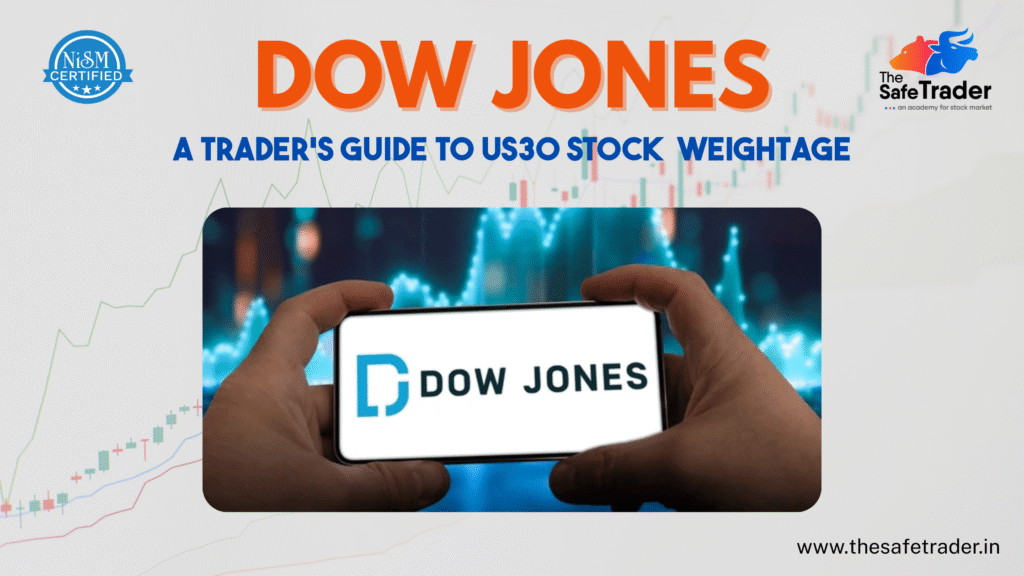Dow Jones Industrial Average: A Trader’s Guide to US30 Weightage

The Dow Jones Industrial Average (DJIA), popularly known as the Dow or US30 on various trading platforms, is certainly one of the most iconic and widely recognized indices among traders. Nonetheless, many traders will admit to not having the slightest idea of how the index works or of how the movement of an individual stock would affect the index. This is all the more crucial to day traders, swing traders, and position traders who use technical or fundamental strategies based on the Dow movement. This blog will explain exactly what Dow really means, how stocks are weighted, and what this means for a trader trying to build an edge. What is the Dow Jones? The Dow Jones Industrial Average, or simply the “Dow,” was created in 1896 by Charles Dow and Edward Jones. It initially comprised just 12 companies, evolving over time into a 30-stock index supposedly meant to represent the broader U.S. industrial economy—yet ironically, not many today are really industrial companies. The DJIA is often referenced as an indicator of general market sentiment and economic health. Blue-chip stocks are included from sectors like technology, healthcare, finance, consumer goods, among others. Quick facts about the Dow Jones: The Dow does not track the overall market like the S&P 500, rather, it cherry-picks the cream of the crop blue-chip companies that are deemed leaders in their industry and considered stable with consistent performance. Price-Weighted: What Makes It Different Most modern-day indices are market-cap weighted, implying that the larger the company, the more influential it is. The Dow, though, is price-weighted, and thus the more expensive a stock, the more it moves the index; the market capitalization of the company is irrelevant here. Example: UnitedHealth (UNH) at $500 can move certain levels in the Dow that Apple (AAPL) at $180 cannot, even though Apple is 3 times bigger in terms of market cap. A 1% move in the price of UNH shares will have a lot more effect on the index than a 1% move in CSCO or INTC. This can cause distortion. A $10 increase in UNH price would add around 70 points to Dow, whereas a similar $10 increase in AAPL price adds only ~36 points. Top 10 Weighted Stocks in the Dow (2025) Below are the most influential components of the Dow based on recent price data (as of May 2025). Keep in mind these weights change slightly with price fluctuations: Rank Company Ticker Price (Approx.) Influence (Weight %) 1 UnitedHealth Group UNH $500 ~9.5% 2 Microsoft MSFT $420 ~8.2% 3 Goldman Sachs GS $370 ~7.3% 4 Home Depot HD $330 ~6.5% 5 McDonald’s MCD $290 ~5.7% 6 Amgen AMGN $270 ~5.3% 7 Caterpillar CAT $260 ~5.1% 8 Apple AAPL $180 ~3.5% 9 Boeing BA $170 ~3.3% 10 IBM IBM $160 ~3.1% Trading Implications of Price Weighting If you engage in Dow (US30) futures or CFDs, including options, knowing price-based weighting is crucial for risk management and strategy formulation. Traders’ Opportunities: Earnings Season: Focus on high-priced stocks like UNH, GS, or MSFT; unexpected events can sway the Dow quite significantly. News Catalysts: One upgrade or downgrade to a high-weight stock sends the entire index in one direction or the other. Correlation Tracking: Occasionally, the Dow rises with some 20 stocks down, just because a few of them are heavily weighted in the index. Risks and Misinterpretations: A Sector Breakdown of the Dow It boasts a variety of companies from a spectrum of industries, some sectors are more represented than others. As of 2025, here is a rough breakdown: Technology: Apple, Microsoft, Intel, IBM, Salesforce, and Cisco Healthcare: UnitedHealth, Johnson & Johnson, Amgen, and Merck Financials: Goldman Sachs, JPMorgan Chase, and American Express Industrials: Boeing, Caterpillar, 3M, and Honeywell Consumer: McDonald’s, Walmart, Procter & Gamble, Nike, and Coca-Cola Note: The Dow has far lesser exposure to technology than the Nasdaq-100, and this directly affects how the index reacts to tech-sector volatility. Some Key Takeaways For Traders and Investors Useful Tools for Dow/US30 Traders Some tools and resources useful for following and analyzing the US30: Final Thoughts Even though Dow Jones looks like a simple index, under its unique price-weighted design lie certain opportunities and pitfalls. Hence an individual trader or investor would have to gain an understanding of what stocks actually drive the Dow’s movement for a piece of constrained market awareness. The US30 continues to retain favor with the intraday and swing traders, being affected by volatility, liquidity, and the psychological factor of world finance. Just make sure you don’t treat it like one other index-because it isn’t. Want to Know More Details, Please Click Here
